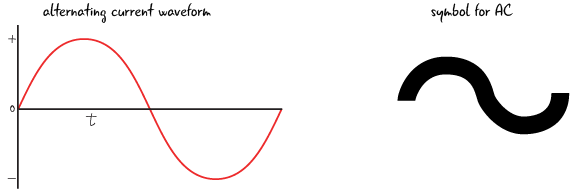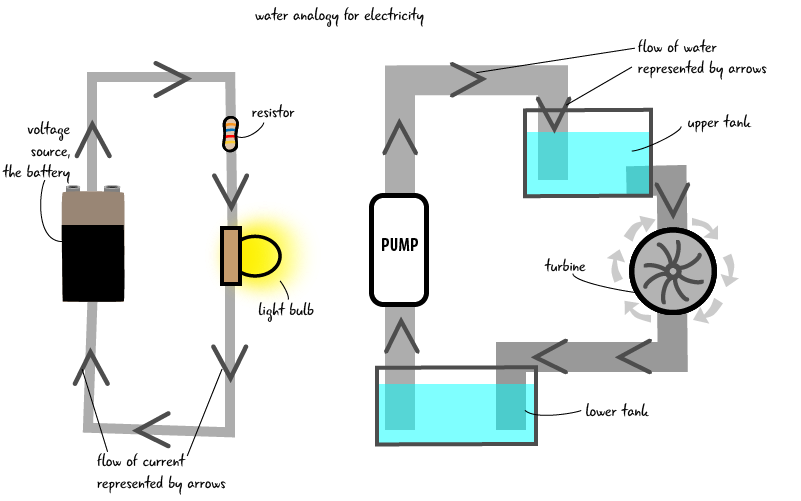Chapter 4: Electricity, an overview
Electricity is flowing electrons

This discussion of electricity is simplified, and relevant to the small scale electronics projects that we are building. We’ve provided some references to more thorough discussions of electricity in appendix xx.
Electricity is the flow of electrons through a material. Electricity requires a closed loop to flow from beginning to end. Our circuits create a closed loop with conductive lines and components. The electricity follows the paths of the circuit.
How does electricity behave?
Materials can be broken down into two different types. The first type of material is conductors, which are good at letting electricity flow. Wires are made out of metal because it is a good conductive material. The second type of material is insulators, which resist the flow of electricity. Rubber is one example of an insulator.
Conductors let electricity flow, while insulators restrict this flow
AC and DC current
There are different types of electrical flow: alternating current (AC), and direct current (DC). The electricity that comes out of your wall socket is AC, while our Arduino and many small electronic projects and components use DC. In alternating current, the flow of electricity changes direction, while in direct current there is only one direction to the flow.

One of the major benefits of AC is that it can be distributed over great distances, something that is much more complicated with DC. AC is also able to increase the amount of voltage supplied much more efficiently than DC. Small scale electronics projects, such as those we create with the Arduino, do not need to transport the electricity great distances, nor do they generally require large amounts of voltage. For these reasons, our descriptions of electricity will be restricted to direct current, which we describe in more depth in the following pages.

Most small scale electronics projects use Direct Current (DC) .
Questions?
Q: Is a battery direct current?
A: Yes, a battery uses direct current.
Understanding electricity: The water tank analogy
Let’s look at the three main properties of electricity:
Voltage, Current and Resistance. We are looking at how electricity works in DC; AC works somewhat differently, and we are not addressing it here. This chapter provides enough info about these properties to let you build your own Arduino projects; however, if have a deeper interest in electronics and electrical engineering, you’ll need to know more than the simplified overview presented here.
In order to comprehend how voltage, current and resistance interact with each other, we will use a common analogy that relates electrical properties to a water system. Below on the left, we see an electrical circuit that has a voltage source, a light bulb and a resistor. The flow of electricity is represented by the arrows. On the right, we have a water system, with a pump, two tanks of water, a turbine and pipes connecting all of the pieces. The flow of water is represented by arrows.

Questions?
Q: Why do we use the water analogy to understand electrical properties?
A: Electrical concepts are necessarily abstract and difficult to visualize. While the water analogy is a simplification of how electrical properties work, it helps us to conceptualize their interaction.
How do we use this analogy to understand the properties of electricity? Let’s look at voltage first. In our electrical system, we have a voltage source, a battery. What is this analogous to in our water system?